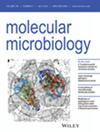Physical models of bacterial chromosomes
IF 2.6
2区 生物学
Q3 BIOCHEMISTRY & MOLECULAR BIOLOGY
引用次数: 0
Abstract
The interplay between bacterial chromosome organization and functions such as transcription and replication can be studied in increasing detail using novel experimental techniques. Interpreting the resulting quantitative data, however, can be theoretically challenging. In this minireview, we discuss how connecting experimental observations to biophysical theory and modeling can give rise to new insights on bacterial chromosome organization. We consider three flavors of models of increasing complexity: simple polymer models that explore how physical constraints, such as confinement or plectoneme branching, can affect bacterial chromosome organization; bottom‐up mechanistic models that connect these constraints to their underlying causes, for instance, chromosome compaction to macromolecular crowding, or supercoiling to transcription; and finally, data‐driven methods for inferring interpretable and quantitative models directly from complex experimental data. Using recent examples, we discuss how biophysical models can both deepen our understanding of how bacterial chromosomes are structured and give rise to novel predictions about bacterial chromosome organization.细菌染色体的物理模型
利用新颖的实验技术,可以越来越详细地研究细菌染色体组织与转录和复制等功能之间的相互作用。然而,对由此产生的定量数据进行解读在理论上可能具有挑战性。在本小视图中,我们将讨论如何将实验观察与生物物理理论和建模联系起来,从而对细菌染色体的组织产生新的认识。我们考虑了三种复杂程度不断增加的模型:简单的聚合物模型,探索物理约束(如封闭或折线分支)如何影响细菌染色体的组织;自下而上的机理模型,将这些约束与其根本原因联系起来,例如染色体压实与大分子拥挤,或超螺旋与转录;最后,数据驱动方法,直接从复杂的实验数据中推断出可解释的定量模型。通过最近的例子,我们讨论了生物物理模型如何既能加深我们对细菌染色体结构的理解,又能对细菌染色体组织做出新的预测。
本文章由计算机程序翻译,如有差异,请以英文原文为准。
求助全文
约1分钟内获得全文
求助全文
来源期刊

Molecular Microbiology
生物-生化与分子生物学
CiteScore
7.20
自引率
5.60%
发文量
132
审稿时长
1.7 months
期刊介绍:
Molecular Microbiology, the leading primary journal in the microbial sciences, publishes molecular studies of Bacteria, Archaea, eukaryotic microorganisms, and their viruses.
Research papers should lead to a deeper understanding of the molecular principles underlying basic physiological processes or mechanisms. Appropriate topics include gene expression and regulation, pathogenicity and virulence, physiology and metabolism, synthesis of macromolecules (proteins, nucleic acids, lipids, polysaccharides, etc), cell biology and subcellular organization, membrane biogenesis and function, traffic and transport, cell-cell communication and signalling pathways, evolution and gene transfer. Articles focused on host responses (cellular or immunological) to pathogens or on microbial ecology should be directed to our sister journals Cellular Microbiology and Environmental Microbiology, respectively.
 求助内容:
求助内容: 应助结果提醒方式:
应助结果提醒方式:


